You don’t get to be number one by sitting on the sidelines. Yet, since rolling out the original T100 more than two decades ago, Toyota has largely been left on the bench in the U.S. full-size pickup market. It remains the only major segment where the world’s largest automaker has repeatedly failed to become a significant, if not dominant player.
But Toyota is nothing if not patient. It took a series of tries to get on the boards in the once-thriving minivan market. And the Japanese maker is betting that it will eventually come up with the right formula for a full-size truck.
Like the one it is showing off in Chicago this week, an all-new version of the Toyota Tundra that has clearly been designed to correct past mistakes. The third-generation Toyota truck features a bolder, more rugged design, a bigger and quieter cabin, and a number of what the maker claims to be truck segment firsts, including Blind Spot Monitoring and Cross-Traffic Alert.
Whether that will be enough to take on the dominant domestics in one of the U.S. market’s largest and most profitable segments, however, is far from certain — especially with all of Toyota’s Detroit competitors digging in to maintain their current ranks. And the Japanese maker will soon face new competition from home as Nissan prepares a redesign of its own, slow-selling Titan.
(For more on the next-generation Nissan Titan, Click Here.)
“Toyota prides itself on listening to its customers and the development of the 2014 American-born Tundra is a perfect example,” contends Bill Fay, group vice president and general manager, Toyota Division.
Toyota has rapidly expanded its U.S. design and engineering operations in recent years, and the maker is billing the 2014 Tundra as “American-born.” No surprise, perhaps, considering this is a distinctly North American segment, with only marginal sales of full-size pickups beyond U.S. borders.
Development of the third-generation Toyota truck was largely handled through the Toyota Technical Center in Ann Arbor, Michigan while design work was the purview of the Calty Design Research centers in Newport Beach, California and Ann Arbor, Michigan. The truck will be assembled at Toyota’s San Antonio, Texas plant, appropriate considering the size of the Lone Star State’s pickup market.
But pickup sales across the U.S. are showing strong signs of revival after the devastating economic downturn. Trucks are closely linked to the housing market which is just beginning what could be a solid upturn over the next several years – making it all the more critical for Toyota to get things right with the 2014 Tundra.
The outgoing truck tried to distinguish itself with a design that wasn’t a me-too clone of the domestic competition. If anything, Toyota is moving more in line with the shape of Detroit sheet metal, something that may be more comforting to buyers in this most traditionalist of segments.
The chrome grille is 1.6-inches taller, the vehicle has a broader, more planted stance. With truck buyers, you can talk “bold,” but there’s a need to make your truck look rugged, durable and able to handle whatever you throw at it without complaint.
Perhaps the place the truck market has been changing most is in the interior. The new Chevrolet Silverado is a good example, opting for an evolutionary exterior design revision but a much more dramatic rejigging of the interior. Toyota appears to be following a similar philosophy.
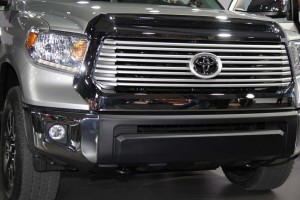
Each of the firve different grades of Tundra will get distinctive exterior and interior details, such as the grille on this SR5.
The cabin of the 2014 Toyota Tundra is, it claims, bigger and more lavishly outfitted. A first glance suggests the maker has trimmed back on the cheap plastic parts and panels that have saved it money but cheapened the look of a number of models over the last decade. The maker claims it has put an emphasis on ergonomics – the driver’s reach for climate and audio controls has been trimmed by 2.6 inches, for example.
Meanwhile, each of the five individual grades gets its own distinct look and feel, something that Ford pioneered with the best-selling F-Series pickup. The Tundra SR5, the volume model in the line-up, will feature a “professional gear” theme, with metal accents and contrasting fabrics in a cabin divided into distinct driver and passenger modes.
The Platinum edition, meanwhile, accents “an urban, contemporary edge,” according to Toyota division General Manager Fay, “appealing to a new generation of buyers.”
If there’s a surprise in the details Toyota has revealed about the new 2014 Tundra it’s the maker’s decision to stick with its existing powertrain line-up, though it claims to have made some tweaks “to improve performance.”
There will still be the three familiar engine options, starting with a 4.0-liter DOHC V-6 making 270 horsepower and 278 lb-ft of torque. It’s paired with a 5-speed automatic.
The midrange engine is a 4.6-liter DOHC V-8 turning out 310 horsepower and 327 lb-ft, while the heavy lifter is the 5.7-liter V-8 churning out 381 hp and 401 lb-ft. Both V-8s are paired to 6-speed automatics. The 5.7 gives the Tundra a maximum 10,400 pounds of towing capacity in the 4×2 regular cab configuration.
With competitors offering a range of new, high-mileage alternatives, notably the popular Ford turbocharged EcoBoost V-6, and with word that General Motors and even Nissan could follow with standard-duty diesels, that raises the question about whether Toyota has more still in the development stage.
CEO Akio Toyota has often suggested he’d like a hybrid for just about every possible model. Could one eventually follow for Tundra? And in a conversation with TheDetroitBureau.com, Toyota division chief Fay suggested one might come out of the Japanese maker’s new joint venture with Ford. The two have teamed up to develop hybrid systems for larger vehicles that could include future truck models.
Innovation has become an increasingly important factor in the pickup market, whether it comes in the form of creative storage nooks or more high-tech features. There’ll be Bluetooth connectivity, of course, and on the safety front the new 2014 Toyota Tundra will be the first full-size pickup to get such features as the aforementioned Blind Spot Monitor and a standard-issue back-up camera. It will also feature eight airbags.
But there are still some things missing from the list. While the new Tundra will come in three cab styles, two-door Regular Cab, four-door Double Cab and four-door CrewMax, all of them offered with either 4×2 or 4×4, that still leaves the third-generation truck lacking the broader range of body styles of key Detroit competitors. And there’s nothing in the way of mid- and heavy-duty models.
Those are significant gaps, some observers caution. Could Toyota have bigger plans yet to come? That’s quite possible, certainly if it has ambitions to generate more than just incremental sales growth. Then again, the maker might have to wait until it does an even more complete tear-up of the Tundra platform later this decade.
It will certainly help that the overall full-size market is making a comeback after sliding to “just” 1.1 million units in 2009, its worst year in decades. Volume rebounded to 1.6 million last year, “and we see it hitting 1.6 million by 2015,” forecast Fay.
Toyota’s share, however, has been miniscule, U.S. sales reaching only 100,000 last year, or less than what Ford sold in under two months.
“We’ll probably not get a whole lot of (additional) volume this year,” cautioned Fay. “We’ll get a lift next year,” Toyota hoping 2014 will see Tundra sales climb to 130,000, still a marginal level.
The new Tundra, backed by Toyota’s marketing muscle, could make some further inroads longer-term but it remains to be seen whether the Japanese giant will finally move from the bench into the front line.

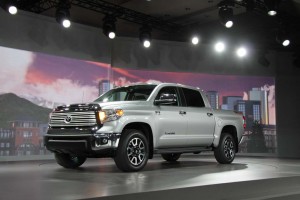
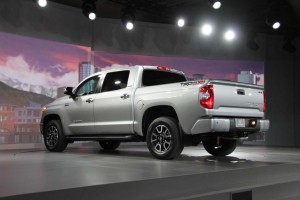
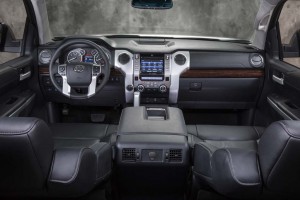
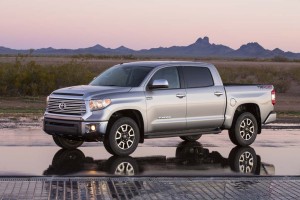
Toyota/Honda have been living on their past reputation. Even CU has admitted their products are not as good as in the past and that other Euro and U.S. car makers have caught up. Toyota trucks have never caught on in the U.S. for a number of reasons including unpleasant styling, lack of confidence in the product and nationalism.
Traditional pick-up trucks were born in the U.S. and are best designed and built by the Big Three. It’s going to take a lot to convince consumers – many of whom use their trucks for business, to jump ship when their is no significant incentive to leave a trusted brand.
Jorge,
I have been cautiously impressed to see Toyota make some important moves on the styling front of late and start to address a decade of cheapening out its vehicle interiors. (I may not personally like the “spindle grille” on Lexus models but the market suggests it works…) That said, I just don’t get the new Tundra. Or the somewhat, slightly, almost new Tundra. It is a weak cosmetic exterior upgrade. The interior is almost a copy of Ford’s F-Series strategy re distinctive models. (Hmmm, 1794 Ranch v King Ranch anyone?) And the complete failure to do anything with powertrain or body derivative was a surprise. I was clearly expecting more. Considering the hit Chevy took for not going far enough with Silverado it will be interesting if Toyota gets a pass or gets hammered for Tundra.
As I did note in the story, there are some possible p-train headlines to come, ie a diesel and a hybrid. Those could wait — along with other major updates — for a more complete remake of Tundra. It needs it. And it will be interesting to see what Nissan does. We already know Detroit won’t relinquish ground readily.
Paul A. Eisenstein
Publisher, TheDetroitBureau.com